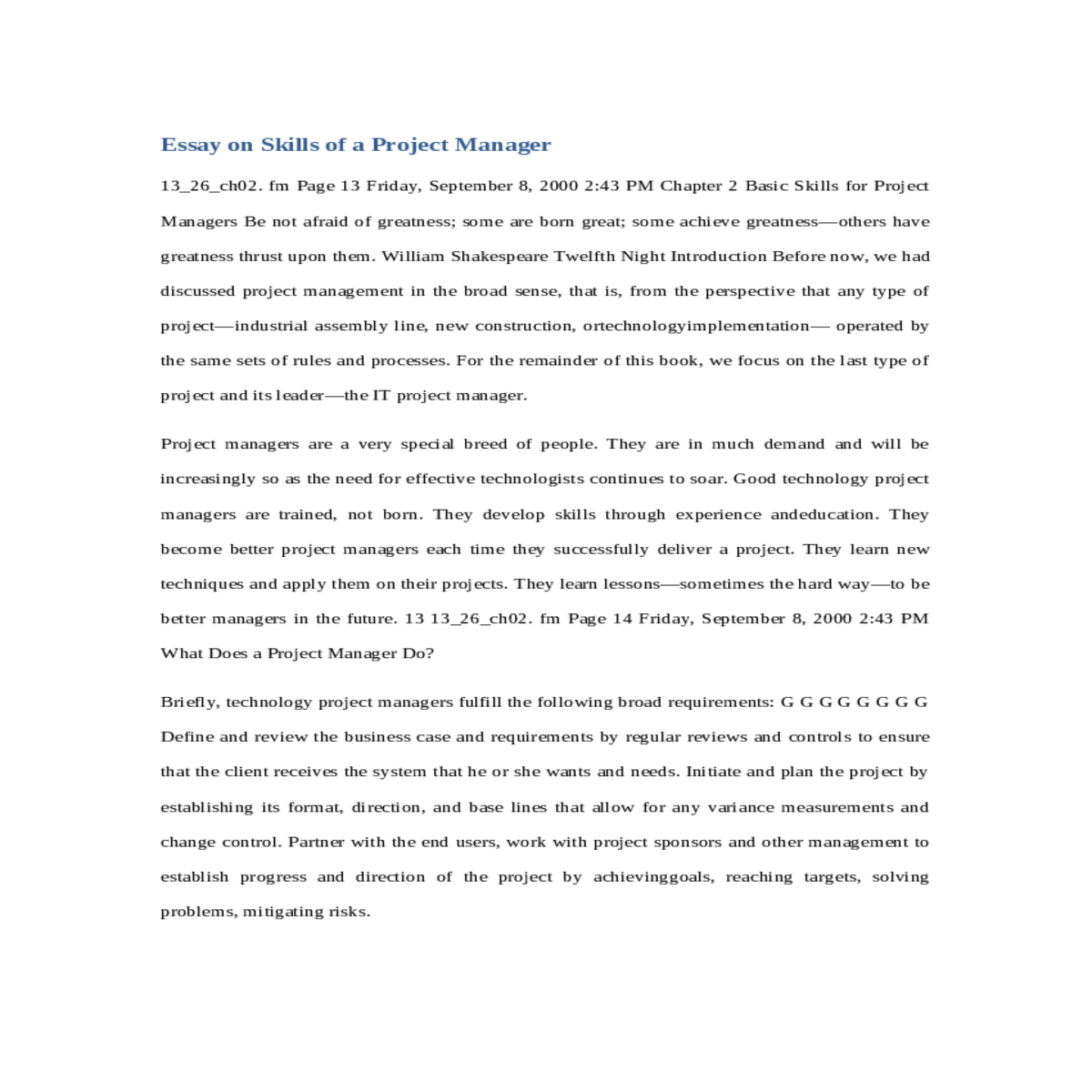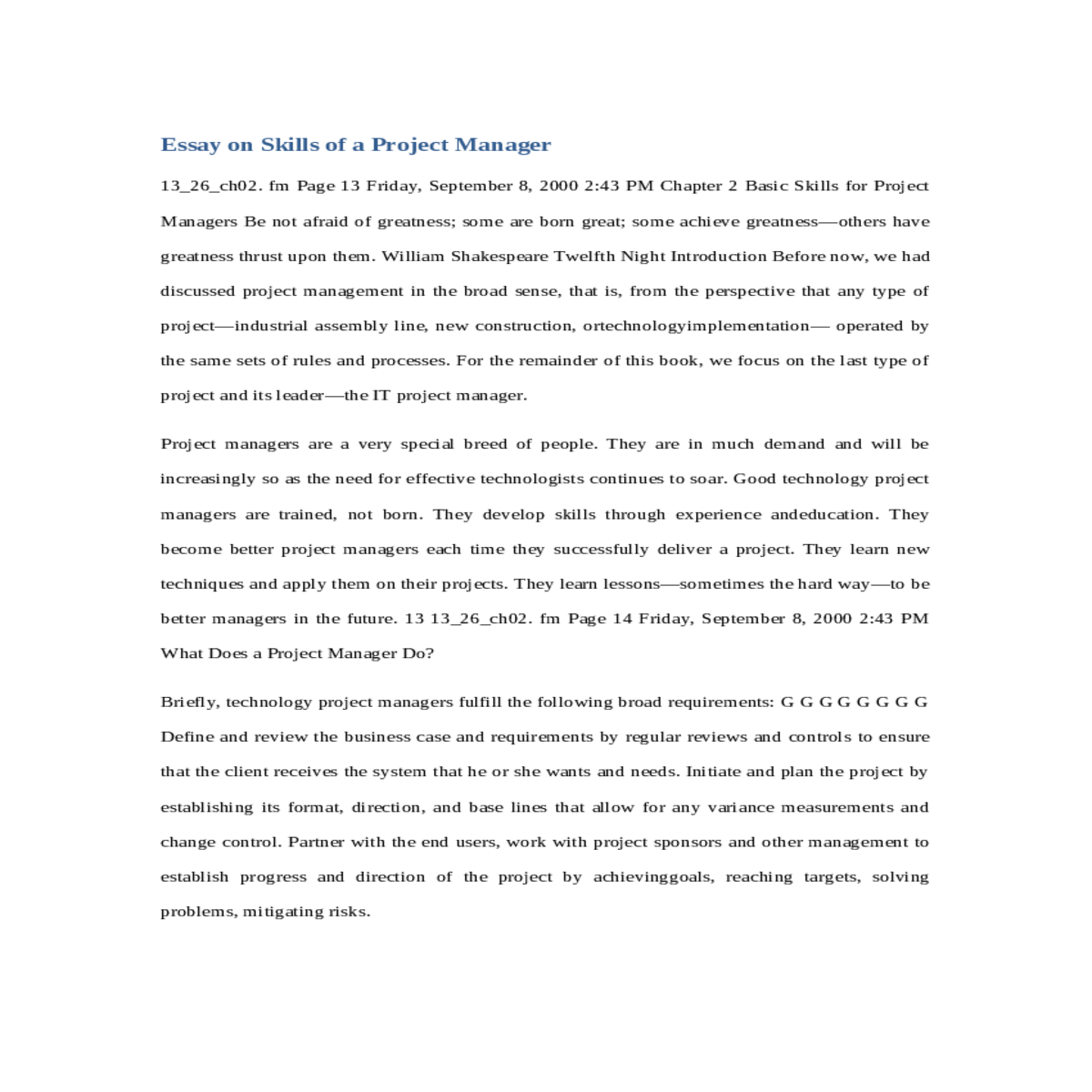Builds teams and organizes team resources
Essay on Skills of a Project Manager
13_26_ch02. fm Page 13 Friday, September 8, 2000 2:43 PM Chapter 2 Basic Skills for Project Managers Be not afraid of greatness; some are born great; some achieve greatness—others have greatness thrust upon them. William Shakespeare Twelfth Night Introduction Before now, we had discussed project management in the broad sense, that is, from the perspective that any type of project—industrial assembly line, new construction, ortechnologyimplementation— operated by the same sets of rules and processes. For the remainder of this book, we focus on the last type of project and its leader—the IT project manager.
Project managers are a very special breed of people. They are in much demand and will be increasingly so as the need for effective technologists continues to soar. Good technology project managers are trained, not born. They develop skills through experience andeducation. They become better project managers each time they successfully deliver a project. They learn new techniques and apply them on their projects. They learn lessons—sometimes the hard way—to be better managers in the future. 13 13_26_ch02. fm Page 14 Friday, September 8, 2000 2:43 PM What Does a Project Manager Do?
A positive attitude. Project managers must always have a positive attitude, even when there are substantial difficulties, problems, or project obstacles. Negative attitudes erode confidence, and a downward spiral will follow. Define expectations. Managers who manage must clearly define what is expected of team members. It is important to do this in writing—get agreement from the individual team members. This leaves no room for problems later, when someone states “It’s not my job. ” Performance expectations must be defined at the start of the project.
Be considerate. Project management is a demanding job with a need for multiple skills at many levels. Above all, be considerate and respectful, and give people and team members the time and consideration they deserve. Make people aware that their efforts are appreciated and the work that they do is important, because it is. A letter, personal word, or e-mail of appreciation goes a long way. Be direct. Project managers are respected if they are direct, open, and deal with all types of problems. Never conceal problems or avoid addressing them.
Project planning, initiation, and organization Recruiting people and keeping them Effective project negotiation Software tools for project management Accurate estimating and cost control Project execution and control Developing powerful project presentations and reports Personal and projectleadershipManaging risk and making decisions Effective problem management Performance management Managing the projects within the organization Project management professional (PMP) exam review Growing and sustaining a high-performance team Managing change within an organization
This last skill cannot be over-emphasized. Although we worry about whether the technology selected is the correct one for the organization and will lead to success, projects do not generally fail because of lack of adequate technology. Statistically, most projects fail because the “softscience” portions of the project have not received enough attention—the human factor has not been adequately addressed. Change, whether for good or for bad, is stressful on an organization and its personnel. The ability to manage this change is one area in which any good project manager would do well to hone skills.
Project Management Skills Development One of the surest ways to align strategies and work force competencies with enterprise vision is to create a road map from vision to execution. A skills management process starts in the future and works its way back to the present. An IT skills management process, for example, links the enterprise vision to a technology forecast. The technology forecasts to required skills, the required skills to the IT skills inventory, the skills inventory to the IT staff’s competence levels, and the competence levels to gaps and to the time frame during which those gaps need to be filled.
Leadership, team building, marketing, business savvy, project management, manufacturing know-how, functional expertise, and institutional knowledge all are part of the skills picture. Skills management serves as an order for managing the work force (see Figure 2–1). It lays out a road map for skills development, work role definition,careertracks, resource management, staffing allocation, workload balancing, and learning. With a road map, all members of the work force can fit their strengths, weaknesses, and alternatives into the enterprise’s plans.
Skills management continues to satisfy those needs, even fos20 Chapter 2 | Basic Skills for Project Managers 13_26_ch02. fm Page 21 Friday, September 8, 2000 2:43 PM tering a niche market of consultants and software developers that are eager to bring order to IT Human Resource management. Before moving on, it is beneficial to make sure that everybody is speaking the same language. In the Gartner Group’s definition of perspective, skills management is a robust and systematic approach to forecasting, identifying, cataloguing, evaluating, and analyzing the work force skills, competencies and gaps that enterprises face.
Although many programs and initiatives adopt the label skills management, most of them focus on skills inventory and fall short in analysis and forecasting. A well-designed skills management process injects a stronger dose of discipline, coordination, and planning into work force planning, strategic planning, professional training and development programs, resource allocation maneuvering, and risk analysis and assessment. Enterprises can reap several lessons from skills management. Skills management works if it: G G G G G
Identifying eight areas of IT professional skills, technical skills being only one area (a detailed discussion on the eight areas identified follows this list) Assigning company values to skills for the near term, short term, and long term Evaluating employee competence levels within the eight areas of IT professional skills Providing continuous training in critical skills, both technical and non-technical Establishing an IT mentor program Supervisors providing performance planning and coaching Establishing team and peer feedback Flattening the IT organization from 18 to 5 titles Chapter 2 | Basic Skills for Project Managers
G G G G G G G 22 13_26_ch02. fm Page 23 Friday, September 8, 2000 2:43 PM G Mapping skills and performance values to “salary zones” within the flatter organization With the help of outside experts, IT executives identified more than 125 skills in eight areas of IT professional development. The eight areas of focus for IT professional development and a sampling of associated skills include: G
Executives must ensure that employees use metrics as a tool for professional development, not as a weapon in cutthroat competition As enterprises turn to technology to reach the next level of corporate performance, IT organizations should identify the skills they need to meet the corporate objectives. Through a program of skills identification, IT organizations can see the holes in their coverage, set priorities for projects, define which training is required, and determine which skills may need third-party coverage. A commitment to funding for training is essential. Conclusions Rarely has a professional field evolved as rapidly as project management. It is totally different from what it was even 10 years ago.
The struggle to stay abreast of new and rapidly evolving technologies, to deal with accumulated development and maintenance backlogs, and to cope with people issues has become a treadmill race as software groups work hard just to stay in place. A key goal of disciplined project managers is to avoid the surprises that can occur when these surprises almost always lead to bad news: canceled projects, late delivery, cost overruns, dissatisfied customers, outsourcing, termination, and unemployment. Indeed, we need to develop management by surprise (MBS) as a project management technique! Keys to a Successful Skills Management Endeavor 25 13_26_ch02. fm Page 26 Friday, September 8, 2000 2:43 PM As we have discussed in this chapter, project managers are a special breed of people.





